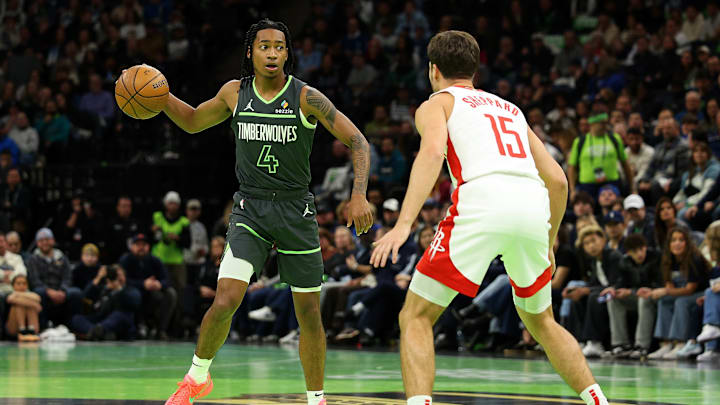Undoubtedly, former Kentucky teammates Rob Dillingham and Reed Sheppard are in similar spots entering their second seasons. Neither guard played much as a rookie on a competitive team, but they showed flashes of what made them lottery picks. However, both the Minnesota Timberwolves and Houston Rockets could have open minutes at the guard spot.
Despite the clear similarities, it seems like many people are far higher on Sheppard than Dillingham. Recently, The Athletic's Sam Vecenie released a re-draft of the 2024 class where he had Sheppard at four, but Dillingham was shockingly outside of the top 20. Vecenie is far from the only one to believe there's a gap between these two players. Bleacher Report did a re-draft where Sheppard went fifth and Dillingham went 14th. While not as severe as Vecenie's ranking, the gap remains.
Even going back to the draft despite having similar profiles, Sheppard was a consensus top-three or five player in most people's eyes, while Dillingham was a consensus top-10 guy. Let's dive into why the gap between these two players is ridiculous.
Dillingham and Sheppard had similar rookie seasons
Simply looking at their counting stats, Dillingham averaged 4.5 points, 1 rebound, and 2 assists on 44.1/33.8/53.3 shooting splits, and Sheppard averaged 4.4 points, 1.5 rebounds, and 1.4 assists on 35.1/33.8/81.3 shooting splits. Sheppard received 2.1 more minutes per game and played in three more games. Of course, counting stats are a limited way to view players, but from a raw production standpoint, they had nearly identical seasons.
As mentioned earlier, both players could be in line for an increased role. However, Dillingham actually has a clearer path to minutes with Mike Conley turning 38 in October and already declining on offense. The loss of Nickeil Alexander-Walker and the Wolves' need for point guard play next to Anthony Edwards further gives Dillingham a clear opportunity. Conversely, the Rockets still have Fred Van Vleet and Aaron Holiday on the roster. There's no guarantee Sheppard won't be behind Holiday again like last season.
Given this, there should be a bit more optimism about Dillingham heading into this season. However, some media members have already boxed Dillingham in as an inefficient shot chucker, all while never criticizing Sheppard.
Sheppard has a perceived higher floor
To play devil's advocate, the reason why some are higher on Sheppard is due to his perceived high floor. Whereas Dillingham's slight frame makes many concerned. Sheppard averaged an impressive 3.2 stocks (steals+blocks) in college. However, there's no evidence he's a productive on-ball defender, especially at the NBA level. Plus, he is only an inch taller and 10 pounds heavier than Dillingham.
The other part of Sheppard's "high floor" is his spot-up shooting and connective playmaking. Sheppard shot a staggering 52.1 percent from beyond the arc at Kentucky and had some of the best offensive analytics heading into the draft. This, paired with his abilities to make the right read and the extra pass, gave Sheppard some impressive offensive versatility.
However, for a prospect with a "high floor," he didn't show much immediate production as a rookie. Despite stellar advanced metrics in college, Sheppard posted a -9.1 net on/off difference with the Rockets. Furthermore, with a more ample sample size (142 vs 74 3s), Sheppard had an identical 3-point percent to the "inefficient" Dillingham.
I'm not saying that Sheppard won't be a productive NBA player. Nevertheless, given what we saw from them in their rookie seasons, it's hard to say there is a massive difference between the two players.
Dillingham unquestionably has a higher upside
While it still could be argued Sheppard has a higher floor, it's hard to argue he has a higher ceiling than Dillingham. Undoubtedly, Dillingham is a more proficient self-creator; he combines blazing speed with dazzling handles and has the ability to make difficult shots look routine. Sheppard simply doesn't have this same skill set.
Rob Dillingham bag work pic.twitter.com/ikL9lHm2VG
— Eamon Cassels (@EamonCassels) August 5, 2025
Dillingham ranked in the 75th percentile for isolation scoring, while Sheppard ranked in the 59th. Additionally, Dillingham shot 52.5 percent on drives, while Sheppard shot just 39.5 percent on drives. However, perhaps the most significant stat to highlight the differences between the two players as self-creators is that 64.5 percent of Dillingham's made field goals were unassisted, while just 38.1 percent of Sheppard's were.
Playmaking-wise, Sheppard is a better connective playmaker. However, Dillingham's dynamic playmaking and passing make him better equipped to be a lead guard.
When looking at successful smaller guards, they are almost always in the self-creator mold, whether they are microwave scorers like Immanuel Quickley or legit stars like Darius Garland. Frankly, how many 6-foot-2 off-ball guards can you think of who play a significant role around the league?
Unless Sheppard develops as an elite shooter, his floor is much lower than what many people realize. Again, I think he can still be a productive NBA player, and it's reasonable to think he can be better than Dillingham, but not by such an immense margin. Ultimately, too many people are focused on Dillingham's weaknesses rather than his strengths, and vice versa for Sheppard.
